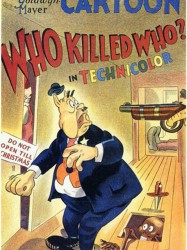Metro-Goldwyn-Mayer cartoon studio

- Infos
- Meilleurs films
Si vous aimez cette entreprise, faites-le savoir !
The Metro-Goldwyn-Mayer cartoon studio was the in-house division of Metro-Goldwyn-Mayer (MGM) motion picture studio in Hollywood, responsible for producing animated short subjects to accompany MGM feature films in Loew's Theaters. Active from 1937 until 1957, the cartoon studio produced some of the most popular cartoon series and characters in the world, including the famous cartoons Barney Bear and Droopy, but particularly its most important creation, Tom and Jerry.
Prior to forming its own cartoon studio, MGM released the work of independent animation producer Ub Iwerks, and later the Happy Harmonies series from Hugh Harman and Rudolf Ising. The MGM cartoon studio was founded to replace Harman and Ising, although both men eventually became employees of the studio. After a slow start, the studio began to take off in 1940 after its short The Milky Way became the first non-Disney cartoon to win the Academy Award for Best Short Subjects: Cartoons. The studio's roster of talent was benefited from an exodus of animators from the Schlesinger and Disney studios, who were facing issues with union workers.
Originally established and run by executive Fred Quimby, in 1955 William Hanna & Joseph Barbera, the writer-directors of the Tom and Jerry cartoons, became the heads of the studio. The cartoon studio was closed in mid-1957, at which time Hanna and Barbera took much of the staff to form their own company, Hanna-Barbera Productions.
Filmographie de Metro-Goldwyn-Mayer cartoon studio (6 films)
Production

Droopy l'intrépide (1951)
, 6minutesRéalisé par Tex Avery
Origine Etats-Unis
Genres Comédie, Animation
Thèmes Mise en scène d'un animal, Mise en scène d'un chien, Mise en scène d'un mammifère
Acteurs Bill Thompson, Tex Avery, Daws Butler, Shepard Menken
Le Grand Barko recherche un chien acrobate. Spike et Droopy sont candidats. Une succession d'épreuves doit les départager. De l'haltérophilie au tir, de l'acrobatie au jonglage, Spike et Droopy s'affrontent donc et les différentes tentatives de Spike pour éliminer son rival tournent à son propre désavantage.

Droopy En Alaska (1945)
, 8minutesRéalisé par Tex Avery
Origine Etats-Unis
Genres Comédie, Animation, Western
Thèmes Mise en scène d'un animal, Mise en scène d'un chien, Mise en scène d'un mammifère
Acteurs Bill Thompson, Tex Avery, Frank Graham, Bea Benaderet, Paul Frees, Pinto Colvig
Le Loup veux tuer Droopy, mais Red va lui faire tourner la tête.

Entre chien et loup (1945)
, 7minutesRéalisé par Tex Avery
Origine Etats-Unis
Genres Comédie, Animation, Western
Thèmes Mise en scène d'un animal, Mise en scène d'un chien, Mise en scène d'un mammifère
Acteurs Paul Frees, Tex Avery, Bea Benaderet, Bill Thompson, Pinto Colvig
Le Loup terrorise la ville et enlève la jeune fille. Il est traqué par les habitants indignés et par Droopy.

Qui a tué qui ? (1943)
, 8minutesRéalisé par Tex Avery
Origine Etats-Unis
Genres Drame, Comédie, Animation
Thèmes Tueur en série
Acteurs Robert Emmett O'Connor, Billy Bletcher, Tex Avery, Sara Berner, Kent Rogers, Richard Haydn
Dans un sinistre manoir, un homme a été tué. Un détective mène l'enquête...
 , 4minutes
, 4minutesRéalisé par Bob Clampett, Friz Freleng, Rudolf Ising, Chuck Jones, Frank Tashlin
Origine Etats-Unis
Thèmes Politique
Acteurs Mel Blanc
Distribution
 , 43minutes
, 43minutesRéalisé par Gene Deitch, Chuck Jones, Maurice Noble, Abe Levitow
Thèmes Films pour enfants
The series features comedic fights between an iconic set of adversaries, a house cat (Tom) and mouse (Jerry). The plots of each short usually center on Tom's numerous attempts to capture Jerry and the mayhem and destruction that follows. Tom rarely succeeds in catching Jerry, mainly because of Jerry's cleverness, cunning abilities, and luck. However, there are also several instances within the cartoons where they display genuine friendship and concern for each other's well-being. At other times, the pair set aside their rivalry in order to pursue a common goal, such as when a baby escaped the watch of a negligent babysitter, causing Tom and Jerry to pursue the baby and keep it away from danger.
 Connexion
Connexion